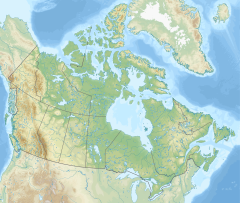St. Lawrence Estuary stretches from west to east for 655 km, from the outlet of Lake Saint Pierre to pointe des Monts,[1] where it becomes the Gulf of St. Lawrence, in Quebec, Canada.
| St. Lawrence Estuary Estuaire du Saint-Laurent (in French) | |
|---|---|
 Maritime section at Port-au-Saumon | |
| Etymology | Saint Lawrence of Rome |
| Location | |
| Country | Canada |
| Province | Quebec |
| Physical characteristics | |
| Source | Saint Lawrence River |
| • location | Lake Saint-Pierre, Trois-Rivières |
| • coordinates | 46°16′17″N 72°38′5″W / 46.27139°N 72.63472°W |
| Mouth | Gulf of St. Lawrence / Atlantic Ocean |
• location | Pointe des Monts |
• coordinates | 49°08′N 67°14′W / 49.133°N 67.233°W |
• elevation | 0 m (0 ft) |
| Discharge | |
| • location | below the Saint Lawrence River |
The estuary is divided into 3 parts, the fluvial estuary, the middle estuary and the maritime estuary.[1][2] The waters coming from the north shore of the St. Lawrence and Labrador come mainly from the Canadian Shield.[3]
Among the deepest and largest estuaries in the world, the St. Lawrence maritime estuary extends nearly 250 km before it widens at Point-des-Monts into the Gulf of St. Lawrence. This enclosed sea is connected to the Atlantic Ocean by Cabot Strait and the Strait of Belle-Isle.

The culture of the First Nations of Quebec, Canada and North America was largely based on birch. The birch bark canoe was a true work of art that provided these hunting peoples with the mobility essential to this way of life.[5][6]
After crossing the Gulf of St. Lawrence, the itinerary of the first Europeans: whalers, fishermen, explorers and navigators enters the waters of the Estuary, where the most difficult manoeuvres of the voyage begin: reefs, shoals, diagonal currents, fog and the presence of shallow channels, often narrow and winding, not to mention winter and ice and its unpredictable and fearsome storms. Throughout its history, the estuary or St. Lawrence River is not easily domesticated.[7]
St. Lawrence Pilots
From Les Escoumins to the Great Lakes, St. Lawrence maritime pilots, experts in navigating specific sectors of the River[8] ensure the safe efficient passage of the vessels under their care.
Fluvial estuary

Running for about 160 km, the fluvial estuary or estuarine section of the river extends from the outlet of lake Saint-Pierre[9][10] to the RCM L'Islet; the portion of the river under the power of freshwater tides.
The average depth of the main channel varies from 13 to 40 m, with pools of 21 m in Trois-Rivières-Ouest and 60 m in Quebec City.[2]
Starting with lake Saint-Pierre, the ecological conditions of the St. Lawrence underwent a radical change. The slow and continuous advance of the great mass of fresh water gradually gives way to the regime of the upflow tide, where twice every twenty-four hours the shores undergo a short alternation of emersion and immersion.[11]
The waters of the streams and rivers that flow into the river differ from those of the St. Lawrence in terms of temperature, chemical composition and suspended solids. The main rivers of the fluvial estuary, on the south shore, are the Bécancour, Chaudière, Rivière du Sud rivers, on the north shore: St. Maurice Champlain, Batiscan, Sainte-Anne, Jacques-Cartier, Saint-Charles, Montmorency rivers and several secondary watercourses.
The waters retain their distinctiveness over a relatively long course before mixing. Those in the Rivière des Outaouais keep their properties up to 25 km downstream from the mouth of the Saint-Maurice. Downstream of Grondines, the currents of the rising tide (flood) reverse the direction of the river's flow. The result is an increasingly homogeneous stiring and mixing of fresh water from different sources.[2]
Flora
Extends along seven kilometres of shoreline in the St. Lawrence River’s fluvial estuary, the Grondines and Sainte-Anne-de-la-Pérade swamp is one of the last, large, treed swamps on the river.[12]
- Grondines and Sainte-Anne-de-la-Pérade swamp, some plants
- Dog's-tooth violeto. – Erythronium americanum Ker-Gawl. — Érythrone d'Amérique
- Ostrich fern. – Matteuccia struthiopteris (L.) Todaro. – Matteuccie fougère-à-l'autruche
- Day lily. – Hemerocallis fulva L. — Hémérocalle fauve
- Red maple. – Acer rubrum L. — Érable rouge (fleurs)
- Corn-flower. – Centaurea cyanus L. ― Centaurée bluet
- Broad-leaved arrow-leaf. – Sagittaria latifolia Willd. — Sagittaire latifoliée
Between Saint-Augustin-de-Desmaures and Île aux Grues, from 2008 to 2012, three plants characteristic of the St. Lawrence freshwater estuary and in a precarious situation were monitored annually: Victorin's gentian (Gentianopsis virgata ssp. victorinii), Victorin's water-hemlock (Cicuta maculata var. victorinii) and Parker's Buckwheat (Eriocaulon parkeri).[13]
Middle estuary

Running for about 195 km, the middle estuary of the St. Lawrence extends, according to the authors, from the eastern tip of Île d'Orléans[15] or Saint-Jean-Port-Joli, to the mouth of the Saguenay River. This estuary section widens rapidly from a few kilometres to 10 km, then to 20 km upstream of Île aux Coudres and the archipelago of L'Isle-aux-Grues.[2]
The middle estuary is mainly characterized by the mixing of freshwater-influenced waters with salt water and high turbidity (turbid water). The hydrodynamic conditions, mainly the reversal of tidal currents and the increase in the salinity gradient, are such that a large amount of suspended solids is trapped and forms a muddy plug (turbidity zone). At ebb tide, the average water flow reaches 90,000 m3/s (fresh and salt water) in Montmagny.[2]
Geomorphology
Over the millennia, several geomorphological events have shaped the landscape of the territory on the south shore of the middle estuary.
The tectonic movements responsible for the genesis of the Appalachian Mountains explain the nature and configuration of the bedrock. Ice and interglacial periods led to glaciations, melts, and marine invasions, ice movements level the Appalachian Mountains. The large layers of sediment in the territory are the legacy of tectonic movements combined whit glacial and interglacial periods.[16]
- Middle estuary, South and Nord shores
- Ferries at the river station dock, L'Isle-aux-Coudres
Maritime estuary

Among the deepest and largest estuaries in the world, running for about 300 km, the maritime Estuary of the St. Lawrence extend, from the mouth of Saguenay River at Tadoussac to Pointe-des-Monts were begin the Gulf.
The two bodies of water that mix off the coast of Tadoussac give the Maritime Estuary characteristics that distinguish it from other reaches of the St. Lawrence: nutrient-rich surface waters throughout the summer and upwellings of deep, cold water that favour the formation of Euphausiids. -Krill beds exploited by large Baleen whales[18] It is home to the southernmost Beluga whale population in the world.[19][20]
This enclosed sea is connected to the Atlantic Ocean by Cabot Strait and the Strait of Belle-Isle.[21]
- Marine Estuary, South and North shores
- Havre du Bic, Route du Golf du Bic, Rimouski, Bic National Parc
Fauna and flora
Habitats
The zone of contact between fresh and salt water corresponds to a region of high concentrations of suspended matter causing a zone of maximum turbidity (MTZ) of a length that can vary from 70 to 120 kilometres (43 to 75 mi), depending on the flow of the river.[24] This zone of maximum turbidity is located between Île d'Orléans (salinity greater than 0 PSU) and Île aux Coudres (salinity below 10 PSU). The mechanisms of estuarine circulation associated with this environment make it a privileged site of primary and secondary production which shelters many fish nurseries. High environmental turbidity provides shelter against predators while larvae are maintained under optimum temperature and salinity conditions.[25][26][27] Large variations in salinity and turbidity result in a wide variety of physicochemical conditions and planktonic communities on the river.
An emblematic species is the beluga (beluga whale), but many other species are present. An identification guide for marine fishes of the estuary and northern Gulf of St. Lawrence was completed in 2008.[28]
See also
References
External links
- Corporation of Pilots of the Lower St. LawrenceLawrence,[1], the expert training, precise knowledge and practical experience required of pilots are therefore indispensable for navigating this river.
- Canadian Tide and Current Tables, St. Lawrence River and Saguenay Fiord, Fiheries and Oceans Canada, 2024, p. 66
- Maurice Lamontagne Institute, Fiheries and Oceans Canada, government scientific basis for the conservation and sustainable management of marine resources and aquatic ecosystems, marine environment protection and safe navigation.
- Conseil du Saint-Laurent Table de concertation régionale du sud de l’estuaire moyen du fleuve Saint-Laurent, groupes de travail : Érosion et submersion côtière, Qualité de l’eau et contamination, Accès au fleuve et marinas, etc. depuis 2014 (French)
- 1998 -Année internationale des océans, Nouvelles des sciences, Institut Maurice Lamontagne, Centre de recherche en science de la mer, 10 pages (Fr)
- David Anderson, Minister of Fisheries and Oceans, at the meeting with the Quebec fishing industry in Montreal, Speech September 10, 1998. Info Oceans, 4 pages (Fr)















